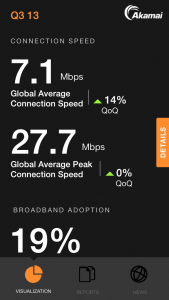 Today’s topic: Akamai’s State of the Internet report. This is not a regular read for me–the need to know the technology behind the curtain is not in my job description. And an interest in technology is just one of many sets in the Venn diagram of my geekdom, and probably not the biggest.
Today’s topic: Akamai’s State of the Internet report. This is not a regular read for me–the need to know the technology behind the curtain is not in my job description. And an interest in technology is just one of many sets in the Venn diagram of my geekdom, and probably not the biggest.
But this year, I was excited to see that Akamai, the Internet services provider, made the report available via a native iOS app. SO COOL!
Recently, the question of how to make long form content available on a mobile device has occupied a corner of my mind. And by mobile, I really mean smartphones. Tablets seem like an easier fit for any form of content from where I sit (which is not in the seat responsible for any of the programming). But the smartphone is a different story. To me, the idea of reading a white paper or report on a smart phone is equivalent to reading a novel like War and Peace on Post-It notes. Not appealing.
But Akamai and their development team at Epictions did content for the smartphone right.
Visualizing the data
The Visualization section houses the data. The home screen in this section displays overall global data–average connection speed, broadband adoption, etc. When you click on Details on the right side of the page, it opens a chart showing quarterly data since 2007. Beneath that graph is a list of countries–you can see their data for Q3 2013 and year over year change. When you select the country, you see a graph comparing that country’s performance to the global data, in one of seven areas of interest (unique IPs, originating attacks, average connection speed, etc). Pretty neat. And handy.
My one complaint here is that on my phone (iPhone 5C), the country list is difficult to scroll through because it is so far down on the screen.
FYI…Originating attacks: China 35.1%, Indonesia 20.5% (representing a 1608% increase year over year, yikes!).
Report
The Reports section includes quarterly reports back to 2008. Each quarterly report is beefy. What they’ve done here is compartmentalize a very long report and make it readable in chunks. Pick a quarterly report and read the letter to the editor. Or the Executive Summary. Or an individual section.
Scroll down in the table of contents to see each section title. Then click on it to read just that section. The content is presented in a single column, designed to be read on a small device. And thank you Akamai for the page count–each section displays page information (Page 1/8), so you know where you are in the document. Small and subtle on the screen, but huge in terms of making it easy for the reader to digest long content.
One downside here is that it is difficult to see the graphics embedded in each section. Click on the graphic and it fills the screen, but I was unable to zoom in on any of the graphic content.
News
The News section shares tweets from Akamai’s State of the Internet account @Akamai_soti. Nice one-stop shopping. Though without other news sources, I’m more likely to just view this particular account in Twitter.
- Salesy quotient
Very low
This is all education, baby! - Educational quotient
Very high
See above.
One thing I think it’s missing to make it even more useful–a link back to the report online and the full archives. But I’m not complaining. And I’m aware it is much easier to critique a finished product that start from scratch to create a brand new one!
Just know: this is a useful app, a really neat way to integrate long content to a small format, and there is a lot to keep a reader occupied with the content they have included.
I also like the blog post that introduced the app: “With the app, you now have a wealth of insight about Internet connectivity and attack traffic right at your fingertips (Win bar bets! Impress your friends!), and it’s easier than ever to catch up on reading back issues of the report (great for those nights when you just can’t fall asleep…).”
Now, I eagerly anticipate an Internet-related bar bet, so I can impress my friends.
What do you think about the app? Is it successful in making long form content available more easily on a mobile platform?
